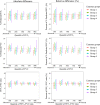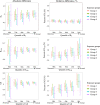Novel approach to studying effects of inhalational exposure on lung function in civilians exposed to the World Trade Center disaster
- PMID: 36828851
- PMCID: PMC9958097
- DOI: 10.1038/s41598-023-30030-2
Novel approach to studying effects of inhalational exposure on lung function in civilians exposed to the World Trade Center disaster
Abstract
It is increasingly important to study the impact of environmental inhalation exposures on human health in natural or man-made disasters in civilian populations. The members of the World Trade Center Environmental Health Center (WTC EHC; WTC Survivors) had complex exposures to environmental disaster from the destruction of WTC towers and can serve to reveal the effects of WTC exposure on the entire spectrum of lung functions. We aimed to investigate the associations between complex WTC exposures and measures of spirometry and oscillometry in WTC Survivors and included 3605 patients enrolled between Oct 1, 2009 and Mar 31, 2018. We performed latent class analysis and identified five latent exposure groups. We applied linear and quantile regressions to estimate the exposure effects on the means and various quantiles of pre-bronchodilator (BD) % predicted forced expiratory volume in one second (FEV1), forced vital capacity (FVC) and FEV1/FVC ratio, as well as the resistance at an oscillating frequency of 5 Hz (R5), frequency dependence of resistance R5-20, and reactance area (AX). Compared with Group 5, which had low or unknown exposure and was treated as the reference group, Group 1, the local workers with both acute and chronic exposures, had a lower median of % predicted FVC (-3.6; 95% CI: -5.4, -1.7) and higher (more abnormal) measures of AX at 10th quantile (0.77 cmH2O L-1 s; 95% CI: 0.41, 1.13) and 25th quantile (0.80 cmH2O L-1 s; 95% CI: 0.41, 1.20). Results suggested heterogeneous exposures to the WTC disaster had differential effects on the distributions of lung functions in the WTC Survivors. These findings could provide insights for future investigation of environmental disaster exposures.
© 2023. The Author(s).
Conflict of interest statement
The authors declare no competing interests.
Figures





Similar articles
-
Association between World Trade Center disaster exposures and body mass index in community members enrolled at World Trade Center Environmental Health Center.Environ Pollut. 2025 Jan 15;365:125414. doi: 10.1016/j.envpol.2024.125414. Epub 2024 Nov 28. Environ Pollut. 2025. PMID: 39615564
-
Association of low FVC spirometric pattern with WTC occupational exposures.Respir Med. 2020 Aug-Sep;170:106058. doi: 10.1016/j.rmed.2020.106058. Epub 2020 Jun 7. Respir Med. 2020. PMID: 32843177 Free PMC article.
-
Characteristics of Cancer Patients in the World Trade Center Environmental Health Center.Int J Environ Res Public Health. 2020 Oct 1;17(19):7190. doi: 10.3390/ijerph17197190. Int J Environ Res Public Health. 2020. PMID: 33019547 Free PMC article.
-
Destruction of the World Trade Center Towers. Lessons Learned from an Environmental Health Disaster.Ann Am Thorac Soc. 2016 May;13(5):577-83. doi: 10.1513/AnnalsATS.201509-572PS. Ann Am Thorac Soc. 2016. PMID: 26872108 Free PMC article. Review.
-
Potential for diffuse parenchymal lung disease after exposures at World Trade Center Disaster site.Mt Sinai J Med. 2008 Mar-Apr;75(2):101-7. doi: 10.1002/msj.20025. Mt Sinai J Med. 2008. PMID: 18500711 Review.
Cited by
-
Association between World Trade Center disaster exposures and body mass index in community members enrolled at World Trade Center Environmental Health Center.Environ Pollut. 2025 Jan 15;365:125414. doi: 10.1016/j.envpol.2024.125414. Epub 2024 Nov 28. Environ Pollut. 2025. PMID: 39615564
References
Publication types
MeSH terms
Grants and funding
LinkOut - more resources
Full Text Sources
Medical

